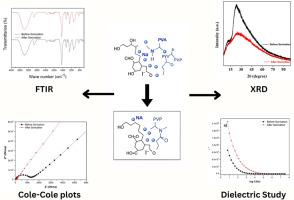Structural and electrical studies of ultra-sonicated sodium-ion embedded polyvinyl alcohol and polyvinyl pyrrolidone solid polymer blend electrolytes
IF 3.4
4区 化学
Q2 CHEMISTRY, MULTIDISCIPLINARY
引用次数: 0
Abstract
Solid-state electrolytes are gaining significant attention as promising candidates for next-generation energy storage systems due to their improved safety and stability. In the present study, a sodium iodide (NaI)-doped polyvinyl alcohol (PVA) and polyvinyl pyrrolidone (PVP) polymer blend electrolyte was synthesized via the solution casting method. To achieve uniform dispersion of sodium ions and enhance the amorphous phase within the solid polymer blend electrolytes (SPBEs), ultrasonication was employed. Structural and optical analyses confirmed that ultrasonication effectively reduces crystallinity, thereby promoting ion transport. Fourier Transform Infrared (FTIR) spectroscopy revealed strong miscibility and interaction between PVA and PVP. Impedance spectroscopy, particularly the Cole-Cole plot, indicated the presence of double-layer capacitance in the low-frequency region. The maximum ionic conductivity was measured to be 6.96 × 10−5 S cm−1 for the ultrasonicated PVA/PVP/NaI SPBE. Dielectric studies demonstrated a significant increase in both dielectric constant and dielectric loss at higher frequencies. Furthermore, electric modulus analysis confirmed the non-Debye relaxation behavior of the polymer blend electrolytes.

超声钠离子包埋聚乙烯醇和聚乙烯醇吡咯烷酮固体聚合物共混电解质的结构和电学研究
固态电解质由于其提高的安全性和稳定性,作为下一代储能系统的有前途的候选者,正受到越来越多的关注。本研究采用溶液浇铸法制备了一种碘化钠(NaI)掺杂聚乙烯醇(PVA)和聚乙烯吡罗烷酮(PVP)聚合物共混电解质。为了使固体聚合物共混电解质(SPBEs)内钠离子均匀分散并增强其非晶态相,采用了超声法。结构和光学分析证实,超声有效地降低了结晶度,从而促进了离子的运输。傅里叶变换红外光谱(FTIR)显示PVA和PVP具有很强的互溶性和相互作用。阻抗谱,特别是Cole-Cole图,表明在低频区存在双层电容。超声处理后的PVA/PVP/NaI SPBE的最大离子电导率为6.96 × 10−5 S cm−1。介电研究表明,在较高的频率下,介电常数和介电损耗都显著增加。此外,电模量分析证实了聚合物共混电解质的非德拜弛豫行为。
本文章由计算机程序翻译,如有差异,请以英文原文为准。
求助全文
约1分钟内获得全文
求助全文
来源期刊
CiteScore
3.50
自引率
7.70%
发文量
492
审稿时长
3-8 weeks
期刊介绍:
The Journal of the Indian Chemical Society publishes original, fundamental, theorical, experimental research work of highest quality in all areas of chemistry, biochemistry, medicinal chemistry, electrochemistry, agrochemistry, chemical engineering and technology, food chemistry, environmental chemistry, etc.

 求助内容:
求助内容: 应助结果提醒方式:
应助结果提醒方式:


